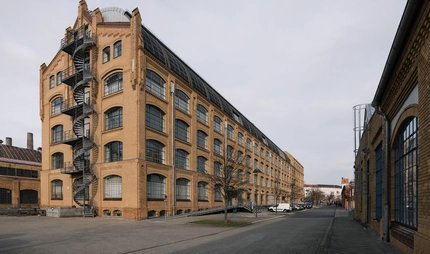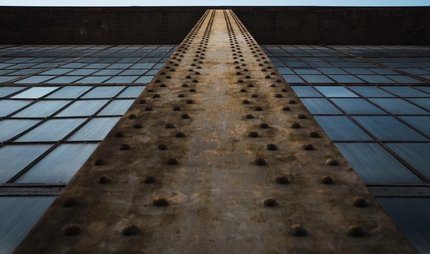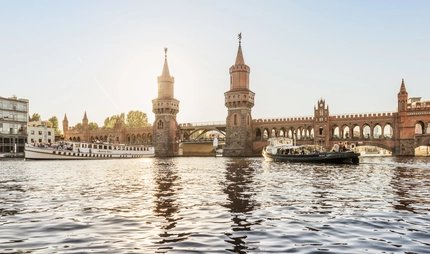
Industrial culture in Friedrichshain
At Stralauer Tor
From the light bulb factories to Osthafen – even today, some of Berlin’s most important industrial buildings can be found north of the Spree in Friedrichshain. Light bulb production has since given way to the creative economy and the heart of Berlin’s music industry now beats in the former dockside buildings on the Spree. And in what used to be the locomotive works, Berliners now go climbing, have parties or watch open-air cinema. But let’s begin at the beginning.
Waterworks, light bulbs, docks
Berlin’s first waterworks opened in 1856 in Friedrichshain, between the Spree to the south and the railway tracks to the north. The engines and workshops from that time can still be seen today. At Rudolfstraße 15 you will find pump station XII, which is still in use. At the beginning of the 20th century, two large locomotive workshops were built, including the repair yard known as RAW II. Where they used to repair rolling stock, you can now spend a whole day on the climbing tower, in the pool, at the open-air cinema or in the bars and clubs.
Our insider tip: the electrical history of the S-Bahn. While RAW II is famous beyond Berlin, the main railway works, Eisenbahn-Hauptwerkstatt I, is relatively undiscovered. The workshop halls are not open to everyone, but there are guided tours where experts show you the site and explain how Berlin’s urban railway was powered with electricity from past to present.
In 1908, Berlin’s electricity board began building a substation in the district. At the same time, Deutsche Gasglühlicht-AG set up a factory on Rotherstraße which became better known as the OSRAM works. From then on, wire production and research and development took place in Friedrichshain. In the 1960s, the brand name NARVA was introduced – and the NARVA-Würfel, the office tower with its cube-shaped glass top, is the most iconic structure in what used to be known as “Lamp City”.
Stretching 1.4 kilometres between Oberbaumbrücke and the railway lines, Osthafen was built in 1907 and was Berlin’s biggest port at the time. Warehouses, offices and cranes dominated the skyline. When you walk along the dockside path you’ll see that Universal Music, MTV and the Fernsehwerft have turned Osthafen into the centre of Berlin’s music and media industries. Fashion labels also have their showrooms here.
From compressed air brakes to fashion start-ups
Talking of fashion, one of Berlin's most famous fashion start-ups has moved into an old industrial building near Ostkreuz in Friedrichshain. Where Knorr-Bremse AG used to develop air brakes is now the offices of the online store Zalando.
Whichever industrial building you find most interesting, the Büro für Industriekultur Berlin offers guided tours, where experts will tell you even more about the history of the sites, as well as some personal anecdotes.
Find out more about the city’s neighbourhoods with our Going Local Berlin app.



